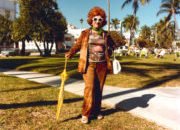
Miami Beach is one of those cities that undergoes enormous transitions every single decade at a pace that is hard to keep up.
In the early 50’s this sleepy seaside resort became a popular vacation destination for blue collar Jews who wanted a break from their tough lives in New York. It later morphed into a place which elderly Jewish people decided was perfect for their retirement. Many were either Holocaust survivors or who had lost much of their family in the war, so they brought with them a joyous zest for just simply being alive.
There were literally hundreds on small hotels in South Beach then that were not only cheap, but were more than happy to cater for their new clientele. Not only by entertaining them and throwing regular parties but also providing a space they could set up schuls to worship.
In the 1960’s young local born photographer Andy Sweet became good friends with fellow photographer Gary Monroe at school and they decided that after they graduated they would go back home to start The Miami Beach Project and together photograph all the new residents.
They had intended this ambitious 10 year project to document how the Beach’s culture had been completely transformed which was something no-one had ever bothered to undertake before. Sweet liked to capture his subjects in full glorious color completely naturally and never posing them or re-configuring their grouping. Monroe on the other hand favoured using black & white film and a more formal approach so the contrast between their work was quite enormous, and it brought a total different viewpoint of a subject when they shot alongside each other.
Their work, imbued with such a wonderful zest for life, is totally exquisite and shows a captivating lifestyle that in its day put the city on the map before totally disappearing.
When the elderly residents started dying off, the small ocean front hotels started to fall into disrepair. It all coincided with the Mariel Boatlift from Cuba and whilst 99% of the refugees were welcomed with open arms, Castro had also emptied his jails too and shipped off all his unwanted criminals. They were the ones that headed for Miami Beach and as the crime rate rapidly soared, the frightened elderly Jewish population eventually started to migrate north for their own safety.
In 1982 Sweet became a crime victim too and aged just 28 was found murdered in his own apartment. The documentary tells us that a motive was never discovered but the surmise is that it was either a drug deal that went wrong, or as Sweet was thought to have been gay, he could have been killed by a sexual partner.
After his death the family put Sweet’s entire archive into a high-end storage facility who then managed to completely lose all of it when they moved premises. It was as his elder sister Ellen said, like losing Andy twice.
However years later Ellen’s boyfriend came across a box of Sweet’s faded prints and thanks to modern technology, and years of patience, managed to resurrect them all to their original glory.
Sweet’s body of highly stylised work is a treasure trove that captures a distant and happy past, that doesn’t just delight historians, but also all of us who are nostalgic for such a seeming more carefree time.
Directed by Kareem Tabsch & Dennis Scholl

